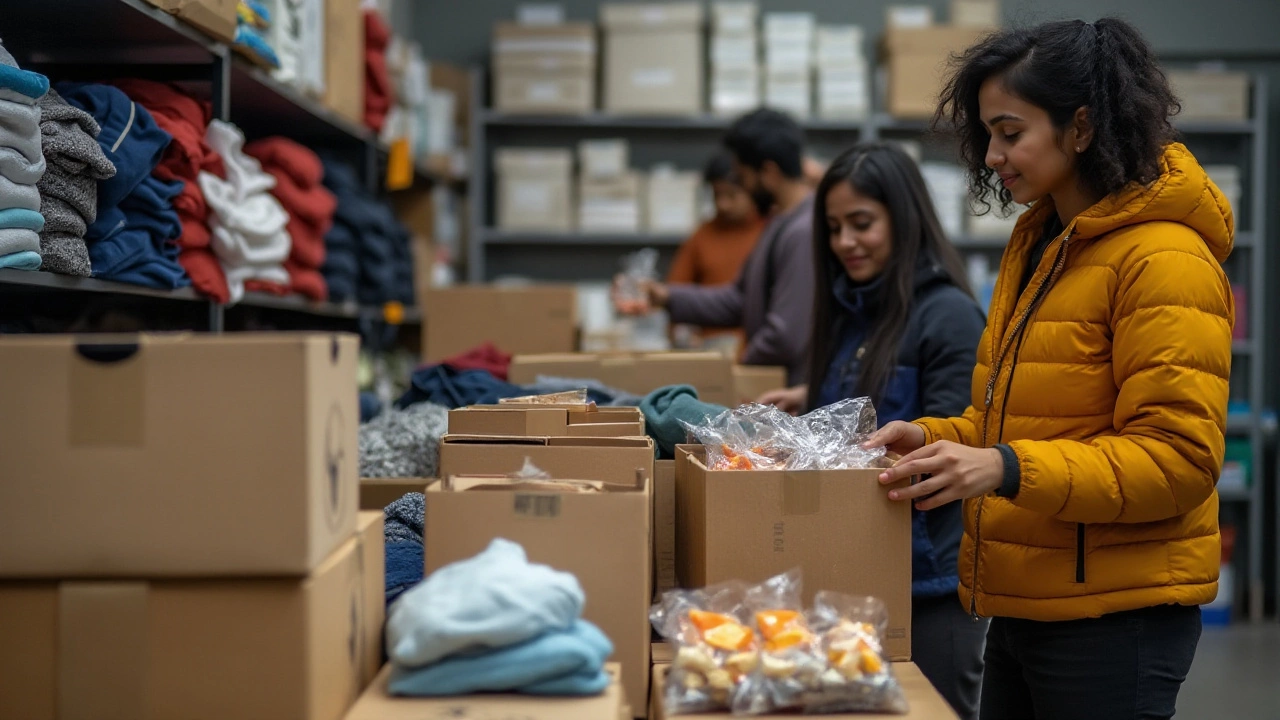Walking into a shelter, one might be struck by the simple things that make a big difference in the lives of those who reside there. From the outside, predicting what the most requested items might be isn't straightforward. It reveals much about the daily hurdles faced by individuals living without a stable home.
Common necessities take on a huge importance, becoming invaluable resources in the daily battle to maintain dignity and comfort. For many, donations mean the world; they bridge gaps between hardship and hope. Discovering which items are the most sought after can guide us in supporting shelters more effectively. We explore the reasons behind these requests and how each of us can contribute meaningfully to this cause.
Understanding the Basics
When stepping into the realm of homelessness and shelters, the basics often root themselves in understanding daily life struggles faced by those without a stable roof. It’s a common misconception that food and shelter are the only essential needs, but as the experience unravels, it reveals intricacies one might not initially consider. A shelter is more than just a place for rest—it’s a community, albeit a transient one, with its own unique set of requirements. Each day in these environments is a balancing act of basic needs versus available resources, and the gaps are more significant than one might imagine. To paint a clearer picture, shelters provide essential services like clothing, hygiene products, health support, and beyond, striving to maintain dignity in the simplest of living conditions.
The items in highest demand are not always food-related. Consider personal grooming and hygiene; these items are paramount for both health and social reasons. When surveyed, residents of shelters often express the difficulty in obtaining these everyday products. Items such as toothbrushes, feminine hygiene products, and underwear don't just support physical health, but they bolster individuals' sense of self-worth and dignity as well. One can't overlook the impact of being able to shave or wash your face when it comes to self-confidence in job interviews or meetings with social services.
The cycle of resource depletion and replenishment is ongoing and often unpredictable. A study reported that in winter, demand for warm clothing skyrockets. Scarcity is unfortunately a common theme, particularly with items like socks, which most of us might not give a second thought to. They provide warmth and help prevent foot-related health issues—often a concern for people on the move or living in less-than-ideal conditions. It's important to remember that shelters can only provide what they receive, making them heavily reliant on donations and volunteer support.
As one shelter operator noted, "things we take for granted are gold to those with less."
Understanding these basics builds not only awareness but also empathy, encouraging more thoughtful donation practices. By grasping the underlying needs—through lists that shelters provide or by speaking directly with those in the field—one can significantly impact with the same resources. It's about making a difference through measured action, ensuring that contributions align with genuine necessity. The most effective way to support shelters is by providing what’s requested, and not what we assume is needed, bridging the gap one donation at a time. This knowledge is power, a catalyst for change, and an invitation to contribute more purposefully.

Top Requested Items
Within the walls of homeless shelters, requests for certain items reign supreme, highlighting a universal need for basic comforts. Toiletries are often top of the list, with toothbrushes, toothpaste, feminine hygiene products, and deodorant being essential. These items are integral to maintaining not just physical health, but self-esteem and dignity, which are often overlooked in discussions of homelessness. A toothbrush, for instance, is more than just a tool for oral hygiene—it can be a prized possession that helps someone feel human and cared for.
Equally important are socks and underwear, items we might take for granted. These essentials wear out quickly, are not often donated, and are crucial for personal comfort. Clean undergarments are vital for maintaining health too, protecting against infections and supporting overall well-being. “The value of something as simple as clean, dry socks should not be understated,” says one shelter coordinator. Clothing donations, notably coats, hats, and gloves, become particularly critical during the colder months, as staying warm can prevent life-threatening conditions such as hypothermia.
Food items, especially non-perishable goods like canned soup, pasta, and peanut butter, are a staple request. Shelters often rely heavily on these to provide meals for residents because while perishable foods are needed, they require proper storage and timely consumption. Non-perishable goods fill the gap, ensuring nobody goes hungry even on days when fresh food is scarce. Every can of food donated helps to stretch limited budgets and resources, underscoring the profound impact of even small contributions.
In addition to food and clothing, shelter staff frequently request sleeping bags, blankets, and mats. These items offer supplemental comfort and make spaces more inhabitable. Sleeping bags can mean the difference between a restless and restful night. To many, a blanket is synonymous with security, and having one’s own to snuggle into at night can provide a semblance of home life, even in a shelter setting.
Lastly, items like backpacks, tote bags, or other portable forms of storage are indispensable. These help individuals carry their belongings as they move from place to place or enter and exit the shelter. When personal space is limited, and privacy is rare, having a secure way to store and transport items provides tremendous peace of mind.
The importance of these goods cannot be overstated. They form the backbone of shelter operations and are always in short supply. Understanding what specific items are requested most often can significantly enhance the effectiveness of our support to the homeless community. Providing these items isn’t just about charity; it’s about restoring dignity, warmth, and agency to those who find themselves at a difficult crossroad in life.

Why These Items Matter
The significance of certain items in a homeless shelter cannot be overstated. When we consider basic necessities like personal care products, warm clothing, or nutritious food, they transcend their physical form to provide comfort, dignity, and a modicum of stability to those experiencing homelessness. It is an unfortunate reality that many everyday items, easily taken for granted by those with secure living situations, become precious resources that significantly enhance quality of life for the unhoused.
Consider personal hygiene products, such as toothpaste, deodorant, and feminine hygiene supplies. These items fulfill essential health needs and also provide a critical sense of dignity. Maintaining hygiene is often linked with self-esteem and confidence, yet it becomes a challenging task without regular access. Research has shown that proper hygiene can not only prevent numerous health issues but also significantly improve an individual's mental wellbeing. Shelters often face a shortage in these supplies, making their donation particularly impactful.
"Hygiene is the foundation upon which health is built," remarks Dr. Jane Collins, a leading public health advocate focused on addressing homeless issues. "For those without a home, it's harder to stay healthy because access isn't constant."
Warm clothing, especially during winter months, can literally mean the difference between life and death. The exposure to elements without sufficient protection can lead to serious conditions like hypothermia or frostbite, both preventable with proper attire. Unfortunately, these items are in constant demand, particularly coats, hats, gloves, and socks. Many shelters report that socks, a seemingly simple item, are among the most desired donations. This is because they wear out quickly and clean socks are crucial for foot health, which can affect mobility and overall health. According to recent surveys, nearly 60% of homeless individuals cite cold weather clothing as their most urgent need in winter.
Food items, particularly non-perishable and nutritious options, are another cornerstone of shelter operations. Access to healthy meals not only tackles the immediate challenge of hunger but also impacts long-term health outcomes. Malnutrition remains a critical issue among the homeless, exacerbating existing health conditions and making recovery from illnesses more difficult. Donating food staples such as canned goods, pasta, and rice can help shelters provide balanced meals regularly. Surprisingly, high-protein snacks like nuts and jerky are often overlooked yet invaluable, given their energy-boosting properties and long shelf life.
Impact on Mental and Emotional Well-being
The influence of these essential items stretches beyond the physical realm, impacting mental and emotional well-being profoundly. For many individuals, the mere act of receiving thoughtful and necessary donations can foster a profound sense of community and support. It can reinforce the notion that society values every person, regardless of their circumstances. This psychological boost can be transformative, encouraging individuals to seek further help or participate actively in rehabilitation programs. As shelters provide these items consistently, they also cultivate an environment of trust and safety crucial for recovery and stability. By recognizing why these donations matter, communities can become more supportive and cohesive, making tangible steps toward alleviating homelessness.

How You Can Help
Supporting individuals facing homelessness can be both rewarding and impactful. There are various ways one can contribute to making a significant difference in their lives, starting with tangible donations to shelters. To maximize the impact of your efforts, begin by reaching out to local shelters to inquire about their specific needs. While canned goods and clothing are often useful, it's the unexpected essentials like personal care items that tend to run scarce. By addressing these overlooked necessities, your donations can fill critical gaps.
Begin by assembling care packages with focus items such as socks, underwear, and hygiene supplies. Socks, for instance, are frequently cited as the most needed yet least donated item. They provide warmth and comfort, playing a pivotal role in the daily comfort of those without permanent shelter. Including travel-sized toiletries such as toothbrushes, toothpaste, deodorant, and feminine hygiene products can be immensely valuable, especially since personal cleanliness is integral to both dignity and health.
Volunteering at local shelters is another impactful way to contribute. Time is one of the most precious resources, and shelters often need volunteers for various tasks such as meal preparation, administrative support, or organizing donation drives. This human connection often gives a morale boost to those you are helping. Listening to their stories and sharing moments of understanding foster a more compassionate community environment. In the words of activist and author Helen Keller,
"Alone we can do so little; together we can do so much."This spirit of togetherness brings hope and solidifies the support network so desperately needed by the homeless.
For those interested in a broader impact, organizing community donation drives or fundraisers can amplify efforts to support the homeless. Use social media platforms to raise awareness and solicit contributions from a wider audience. Creating an event that engages local businesses can also increase the collection of requested items, ensuring that shelters are better stocked to meet immediate needs. Furthermore, collaborating with organizations that focus on shelters allows for a collective pooling of resources, maximizing the overall benefit to those in need.
Education and advocacy are equally vital in making long-lasting changes. Raising awareness about homelessness, its causes, and the hardships while dispelling common misconceptions can foster empathy and proactive community support. Joining local advocacy groups or assisting in policy discussions that focus on creating long-term solutions for homelessness can contribute to systemic improvements. With informed advocacy, we can work towards shifting societal perspectives and developing sustainable strategies to decrease the rising numbers of those living without a home.







